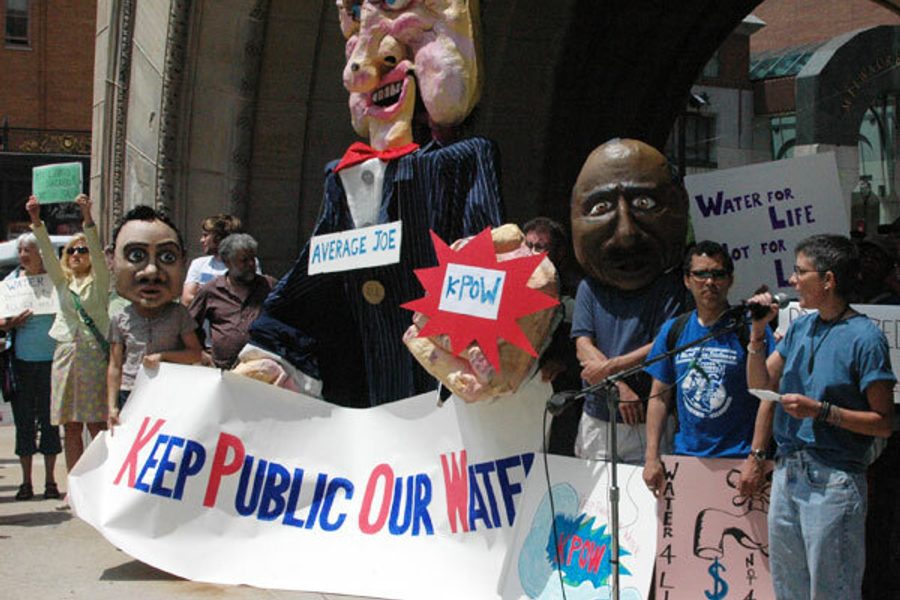Auto Task Force Outsources Jobs
Obama’s recovery plan steers GM and Chrysler in the wrong direction .
Roger Bybee

As rescue attempts go, the Obama administration and its Auto Task Force are pursuing a peculiar course: They seem intent on keeping General Motors and Chrysler afloat as corporate entities by tossing more U.S. workers overboard.
Even as unemployment rates soar in longtime GM-centered communities hit by shutdowns, such as Janesville, Wis. (14.7 percent), and Flint, Mich. (15.3 percent), Obama and his task force pressed GM and Chrysler for more cuts. GM plans to shut down at least 14 factories and discard some 21,000 workers. Chrysler is closing eight U.S. plants, though it claims that somehow its merger with Fiat will result in a new increase of 5,000 jobs. In a telling observation that carried unsettling echoes of Bill Clinton’s push for NAFTA, the New York Times called the job cuts and other worker sacrifices “steps that most analysts thought could never be pushed through by a Democratic president allied with organized labor.”
The most recent version of GM’s recovery plan – closely tailored to the demands of the task force – calls for a stunning 98 percent increase in autos produced in Mexico, China, South Korea and Japan for the U.S. market. In May, the United Auto Workers (UAW) and United Steelworkers launched a 36-city campaign to prevent GM “from importing small cars from China, a move that would have increased GM’s profits while very likely reducing the number of domestic automobile jobs,” the New York Times reported June 2. This last-minute drive was successful, but it’s still unclear exactly what modifications GM will make.
For its part, Chrysler announced May 1 (the day after it filed Chapter 11 bankruptcy) the closing of its Kenosha, Wis., engine plant and the transfer of many of the plant’s 850 jobs to Mexico. As recently as the day before, top Obama administration and Chrysler officials had assured Wisconsin legislators that the Kenosha plant would be preserved. Faced with a firestorm of protest for using federal dollars to transfer jobs to Mexico, Chrysler now says that Fiat will consider keeping the plant open.
On top of all that, job losses will balloon with the closing of more than 1,100 GM and 789 Chrysler dealerships, eliminating tens of thousands more jobs.
Although Obama hasn’t ordered auto industry cuts himself, “the revamping of the nation’s largest car company is being guided by the administration’s auto-industry task force, and it follows the president’s calls for a leaner, healthier industry,” DowJones.com reported on May 12. The Obama administration’s downsizing of the auto industry, established as a precondition for approximately $30.5 billion extended thus far in loans to GM and Chrysler (with another $20 billion in the pipeline), sharply contrasts with the lightly-conditioned, larger bailout of Wall Street. Nomi Prins, author of It Takes a Pillage, a forthcoming book on the Wall Street meltdown and its roots in Washington, estimated that Wall Street has received $12.5 trillion – nearly 400 times more – in loans, loan guarantees and taxpayer subsidies for the sale of risky loans.
Contradictory policies
Only three of the Auto Task Force’s members were notably pro-labor, despite protests from labor and auto-state lawmakers. “The Auto Task Force members are basically red-pencil types who looked at saving the auto industry on the cheap without much consideration to social costs, let alone generating green alternative jobs for auto,” says economist and author William K. Tabb. “They have the narrowest business criteria for auto, unlike the banks that got capital and loan guarantees worth trillions. So their focus was to save the auto companies but not the auto workers.” Essentially, Obama and the task force wanted a quick and cheap solution to the Big Three’s ailing finances rather than providing an endless flow of resources, as the government did to the “too-big-to-fail” financial sector.
Bizarrely, the Auto Task Force’s policy direction dramatically undercuts Obama’s $787 billion economic stimulus program. “The problem with GM’s new Washington-mandated restructuring plan is that it steps on the gas in the wrong direction,” UC Berkeley professor Harley Shaiken told NPR’s “Marketplace.” “The stimulus package spends $800 billion to create jobs, while billions in loans to GM are conditioned on eliminating them.”
In addition to the factory job and dealership cuts, GM will unload its Pontiac, Saturn and Hummer brands. By contrast, the Italian government provided $1.7 billion in aid to Fiat as long as Italian plants stay open, noted Robert L. Borosage of the progressive coalition Campaign for America’s Future. Also, France loaned $8.5 billion to its big three automakers, in exchange for pledges to keep jobs in France.
Labor advocates fight back
After months of the UAW trying to avoid a fight with Obama, in early May it began openly challenging the use of taxpayer loan money to finance the outsourcing of jobs. “We believe (GM) should have an obligation to build in this country the vehicles it will be selling in the U.S. market, thereby maintaining the maximum number of jobs in the United States,” UAW legislative director Alan Reuther wrote to the Senate.
Former Clinton Secretary of Labor Robert Reich blasted the notion of paying billions of taxpayer dollars to keep companies afloat while they cut tens of thousands of jobs and wages. “We’re transferring money from taxpayers to Big Three shareholders for no apparent reason other than the Big Three are headquartered in America,” he said. “Why should taxpayers foot any of this bill unless the Big Three agree to keep their workers employed while they try to turn themselves around?”
The full answer to that question remains unanswered at this moment, as the two corporations’ plans for future outsourcing are unavailable. But significantly, the Auto Task Force didn’t explicitly require that federal assistance be directed to renewing production in the United States. Furthermore, following conventional management wisdom, “the Obama administration structured the GM and Chrysler plans to lessen the union’s voice in management,” the New York Times stated.
But so far, the mainstream media hasn’t much noticed or criticized the contradictions between Obama’s plans to simultaneously stimulate job growth and shrink GM and Chrysler. With all the attention on unwarranted Wall Street bonuses, major media lump Wall Street brokers’ compensation and CEO pay with autoworkers wages as part of the same culture of “excess.” Reports that autoworkers were paid as much as $73 an hour quickly spread through the media.
Actually, the typical wage is $26 to $28 an hour, plus an additional $10 or so in benefits, according to the Center for Automotive Research. UAW’s agreement to accept a new starting wage of $14.20 an hour with vastly reduced benefits received little attention. Neither did the fact that UAW-represented plants ranked “very favorably” on quality and productivity compared to Japanese “transplants” in the United States, according to independent industry assessments.
Shielded by a lack of accurate and coherent media analysis, the Auto Task Force used a narrow and conventional single-firm turnaraound framework to create a strategy for GM and Chrysler. “A hedge fund wants to make money fast for its client – in this case, the taxpayer – without regard to social cost,” Shaiken says. “Unlike most clients, however, the taxpayer picks up the social cost. Longer unemployment lines and more foreclosures are devastating for the victims, not cheap for the rest of us.”
But the Auto Task Force seemed largely oblivious to the human costs of eliminating thousands of U.S. auto jobs. Obama and his task force withheld billions of dollars in new loans requested by GM until after the company came up with a more aggressive program of job cuts, plant closing and outsourcing. The Auto Task Force rapidly divorced the reinvigoration of GM and Chrysler from a longer-term shift to a fuel-efficient economy and production not just of high-mileage cars, but also of mass-transit equipment for buses and high-speed rail.
Ironically, GM’s ruthless downsizing of its U.S. workforce and outsourcing of jobs over the last 25 years diminished its leverage with the Obama team. GM has discarded 85 percent of its domestic production since 1990 – and that was before it hit the current recession and the resultant nosedive in sales. It was no longer “too big to fail.”
So Obama and the Auto Task Force felt free to promote a recovery strategy for the two ailing auto firms that stands in appalling contrast to the generosity shown Wall Street. GM and Chrysler headquarters will remain intact, but thousands of U.S. workers will be vaporized, retiree health benefits could be put on the chopping block (especially at Chrysler) and numerous industrial communities will suffer permanent damage. And the Obama team has forfeited the opportunity to recast the current crisis into a fuel-efficient re-industrialization of America – right when the country needs the stimulus of high-wage green jobs the most.









